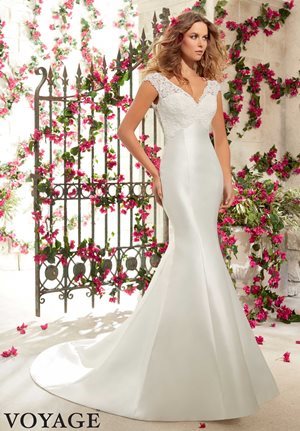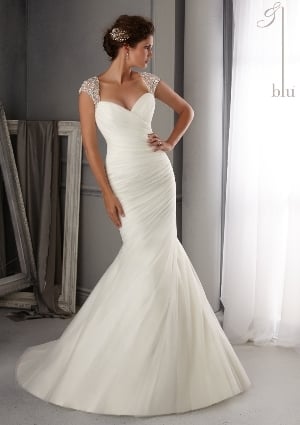
The waistline of your wedding dress is essential in defining your overall wedding day look. It is one feature that can make all the difference between whether you look tall or short and slender or curvy. Picking the correct waistline for your dress can help you balance your entire look.
Let us look at the various types of waistlines on wedding dresses and help you identify the ones that are right for your body shape.
Table of Contents
Basque

This waistline lies close to the natural waist, but the seams from either side interconnect to form an inverted triangle in the front. It is usually found on structured ball gowns, where it defines the beginning of a layered skirt and minimizes the size of the hips.
It looks best if you are pear-shaped or have an hourglass figure. This is because the dip in the center creates the illusion of length, and the pattern is slimming.
Avoid if you have a large waistline or if you are apple-shaped.
Empire

The waistline is defined right below the bust, and the skirt usually flows loosely to hide the natural waist while drawing attention to the chest.
It looks best on shorter brides who wish to look lean and tall and brides with tiny busts. It is also a good choice if your tummy looks puffy despite using inner shapewear.
Avoid if you are large-chested, as the pattern draws focus to your chest area.
Dropped Waist

A dropped waist falls lower than the natural waistline. It creates the illusion of a longer and leaner torso.
It looks best if you have a slight natural waistline, an hourglass figure or wide hips.
Avoid if you are petite or if your natural waistline is already low.
Natural Waist

As the name suggests, the waistline of the dress coincides with your actual waist, just above your hips. It creates an hourglass figure while reducing your length by adding a seam at the centre.
It looks best if you have a slender waist or are hourglass-figured. When the dress is a ball gown, it works for pear-shaped brides too.
Avoid if you are apple-shaped.
Asymmetrical

Another more popular design is the asymmetrical waistline, where the seams drape the body asymmetrically, usually in a diagonal fashion. It suits most body types when done correctly in a suitable fabric that holds its shape.
It looks best on brides who are tall and slim, with an hourglass figure.
Avoid if you are short, as the diagonal drape of the waistline can make you look even faster.
No Waistline

These dresses have no noticeable waistline. Instead, it flows gently from the bodice to the skirt, fitting snugly along your natural body curves.
It looks best on brides with hourglass figures or those slender with just the right amount of curves.
Avoid if you are rectangular or wish to camouflage any problem areas with the help of your wedding dress silhouette.
While these rules can help, a dress may drape differently from expected. The best way to find out is to try it on and see for yourself.
To check these wedding dresses out, or to find more options in the pattern you love, visit us at Best for Bride.













I always like the look of the empire waistline!
Me too, but doesn’t that basque waist look very similar?
I always had an empire waist of an idea in my mind. I am taller and slim, so according to what you have posted here, that should work well!
I think I am going to go with a dropped waist.